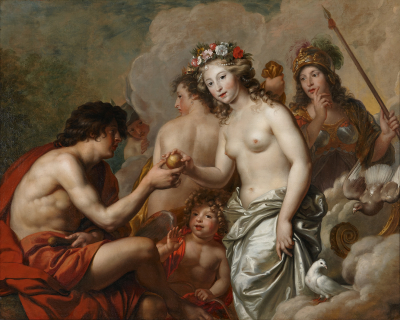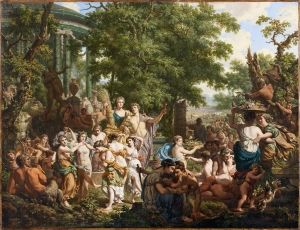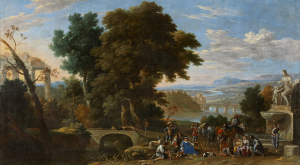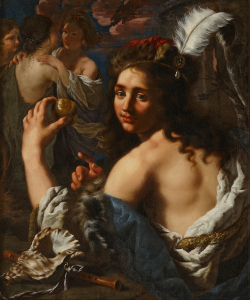Adriaen Backer (ca. 1635-1684), The judgment of Paris
Adriaen Backer (ca. 1635-1684), The judgment of Paris
Adriaen Backer was born in Amsterdam in 1635 or 1636. This can be concluded from the statement that he was 33 years old when he married Elsje Colijn in August 1669. He died in May 1684 (see A.A. van Suchtelen, ‘Adriaen Backer’, in Saur Allgemeines Künstler-Lexikon, Band 6, München/Leipzig 1992, p. 167.) Adriaen was the nephew and (most likely) a pupil of the painter Jacob Backer (1608/9-1651), who is well-known as one of Rembrandt’s most talented pupils. In 1666 Adriaen was in Rome together with the painter Dirck Ferreris (1639-1693) from Enkhuizen. He had arrived a few years earlier, because in 1659 Adriaen drew up his will stating that he was about to travel abroad. In December 1667 he returned to Amsterdam. Adriaen Backer made a successful career as a painter of history scenes, portraits (including group portraits of Amsterdam regents), ceiling paintings and decorative pieces. He received some important commissions from the city of Amsterdam and Haarlem; he made paintings for the town hall in both cities. As an artist he followed the taste for the classicist style that was dominated by the painter Gerard de Lairesse (1640-1711) who originally came from Liège. In 1665 he had established himself in Amsterdam and with great vigor he introduced the internationally highly appreciated classical style of French painting (Alain Roy, Gérard de Lairesse 1640-1711, Paris 1992). This style is characterized by sparkling colors and bright lighting. Also the choice for the nude, based on classical examples, that were known thanks to sculptures and prints, is a hallmark of this sophisticated art. The choice of subjects was dominated by stories taken from Greek and Roman literature. This followed the fine taste for Antiquity that prevailed in the later decades of the seventeenth century. The French academic style was generally accepted as the leading movement in art and it irrevocably affected many artists.
‘The judgment of Paris’ demonstrates the impact of De Lairesse on the art of Adriaen Backer. This becomes immediately clear when Lairesse’s painting of ‘Venus wounding Cupid with his own arrow’ is compared to ‘The judgment of Paris’. Both paintings were painted in the early 1670s when Adriaen Backer was very sensitive to Lairesse’s art. The resemblances are obvious, but compared to Lairesse, Backer is more linear in the way he paints figures. Lairesse shows his persons in a smooth way by applying the paint in a variety of subtle color tones. Backer is stronger in the combination of colors that clearly stand out. An illustrative example of this is Backer’s ‘De Bordes family portrait’ that he painted in 1673. The painting shows Anthony de Bordes (1615-1678) to the right, and his son Antoni de Bordes junior, who is guided by Pallas Athena (or Mineva), the goddess of wisdom. She leads the boy to a table where objects of educations are presented, like books, a globe and musical instruments). Two young boys with curly hair are being pushed aside by Anthony. They are still playing (one holding a top and whip,
the other blowing bubbles) and toys of childhood are scattered on the floor (a hoop, knucklebones and marbles). This indicates that the young man, from now on, will leave his childhood behind him. The figure of Minerva reappears in ‘The judgement of Paris’, and the little boy standing in the middle of that painting resembles the two young boys in the ‘De Bordes family portrait’. The stylistically comparisons make clear that the painting of Paris must be attributed to Adriaen Backer. A similar color scheme, with shining red and grey garments, can be seen in his allegory of ’The seven capital Sins punished by Justice’ in the Town Hall of Haarlem that Backer painted in 1671.
The subject of he judgment of Paris belongs to the best known stories from Greek mythology. Paris, the son of the king of Troy, was asked to be the judge in a beauty contest. This was maliciously set up by Eris, the goddess of disconcert, who wanted to provoke the gods. Paris had to choose one of three goddesses: Hera (Juno in Roman mythology), Pallas Athena (Minerva) or Aphrodite (Venus). As a token of his choice he must give a golden apple (or golden ball) to one of them. Each tried to gain his favor by promising Paris priceless gifts. Hera and Athena promised riches, power and wisdom, but Aphrodite outwitted them by promising Paris the highest gift of love. She would give him the hand of Helena, the most beautiful woman on earth. Paris falls for this temptation and he gives the apple to Aphrodite. Exactly this moment is shown in the painting. Mercury, the messenger of the gods, is looking from behind a cloud, and he will spread the news around. Aphrodite keeps her word and arranges that Helena leaves her husband Menelaos, king of Sparta, and goes to Troy with Paris as her new husband The affair led to an enormous political upheaval that eventually resulted in the Trojan War. The meaning of the story is that man should not choose for sensual love because it leads to trouble. A wise man must choose for wisdom and reason. The subject of ‘The judgment of Paris’ was very popular in art because it gave the artists the possibility to depict three beautiful women, essentially semi-nude or scantily dressed, because that is part of the story.
- Period
- ca. 1675
- Material
- oil on canvas
- Dimensions
- 125 x 157 cm
Global shipping available









